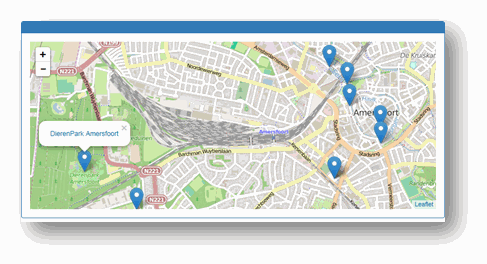-
Notifications
You must be signed in to change notification settings - Fork 21
GeoAppearance
You use a GeoAppearance if you want to show some geographical data on a map. Two maps are includes:
- The Openstreet map;
- The Official topographical map of the Netherlands.
To place a simple marker on the map, your data should contain a geo:long and a geo:lat property value. If you add more than one marker on the map and you want to centre the map arount a particular marker, you can state that this marker is of rdf:type elmo:GeoLocator.
To place one or more geometrical shapes on the map, your data should contain one or more geo:geometry values.
In both cases, the URI of the subject will be used to create a hyperlink to that particular URI. If you want to override this hyperlink, you should add a xhtml:link property as well. If you want to add a pop-up with a label, you should add a rdfs:label property.

The appearance of each row can be changed with the elmo:fragment statement:
- (mandatory):
elmo:applies-tostates the predicate to which the fragment applies. -
elmo:backmapstates which map to use ('brt' means the Dutch topographical map, if you ommit such a statement, the Openstreet map is used). You should use this statement in combination with aelmo:applies-to elmo:Appearancestatement. -
xhtml:stylesheetstates the particular css stylesheet to be used for a particular shape style. Your query result should include anelmo:styleproperty that refers to the particular style fragment.
The first example just places a pointer on a OpenStreet map. In this case, the rdf:type elmo:GeoLocator statement is not really necessary, because only one marker is visible.
stage:GeoAppearancePointer a elmo:Part;
elmo:appearance elmo:GeoAppearance;
elmo:query '''
prefix geo: <http://www.w3.org/2003/01/geo/wgs84_pos#>
construct {
<urn:pointer> rdf:type elmo:GeoLocator.
<urn:pointer> geo:lat "52.155".
<urn:pointer> geo:long "5.38".
<urn:pointer> rdfs:label "Here!".
}
WHERE {}
''';
.
The second example shows the city of Amersfoort in the color red, using the Dutch Topographical map.
@prefix elmo: <http://bp4mc2.org/elmo/def#>.
@prefix xhtml: <http://www.w3.org/1999/xhtml/vocab#>.
@prefix rdfs: <http://www.w3.org/2000/01/rdf-schema#>.
@prefix stage: <http://localhost:8080/stage#>.
stage:GeoAppearance3 a elmo:Representation;
elmo:url-pattern "query/geo3$";
elmo:appearance elmo:GeoAppearance;
elmo:fragment [
elmo:applies-to "city";
xhtml:stylesheet '''
fill: red;
fill-opacity: .3;
stroke: #666;
''';
];
elmo:query '''
prefix geosparql: <http://www.opengis.net/ont/geosparql#>
prefix brt: <http://brt.basisregistraties.overheid.nl/def/top10nl#>
prefix geo: <http://www.w3.org/2003/01/geo/wgs84_pos#>
prefix elmo: <http://bp4mc2.org/elmo/def#>
construct {
?owis rdf:type elmo:GeoLocator.
?city geo:geometry ?wkt.
?city rdfs:label ?cityname.
}
WHERE {
select *
where {
?city rdfs:label ?cityname.
?city geosparql:hasGeometry ?geo.
?geo geosparql:asWKT ?wkt.
FILTER (?city = <http://bag.basisregistraties.overheid.nl/bag/id/woonplaats/1664>)
}
limit 1
}
''';
.
- Home
- Theatre installation
- Tutorial
- Using the theatre
- Configuring the theatre
-
Appearances
- CarouselAppearance
- ChartAppearance
- ContentAppearance
- GeoAppearance
- GeoSelectAppearance
- GraphAppearance
- FormAppearance
- FrameAppearance
- HeaderAppearance
- HiddenAppearance
- HtmlAppearance
- IndexAppearance
- ImageAppearance
- LoginAppearance
- ModelAppearance
- NavbarAppearance
- NavbarSearchAppearance
- ShortTableAppearance
- TableAppearance
- TreeAppearance
- TextAppearance
- VocabularyAppearance
- LDT Vocabulary